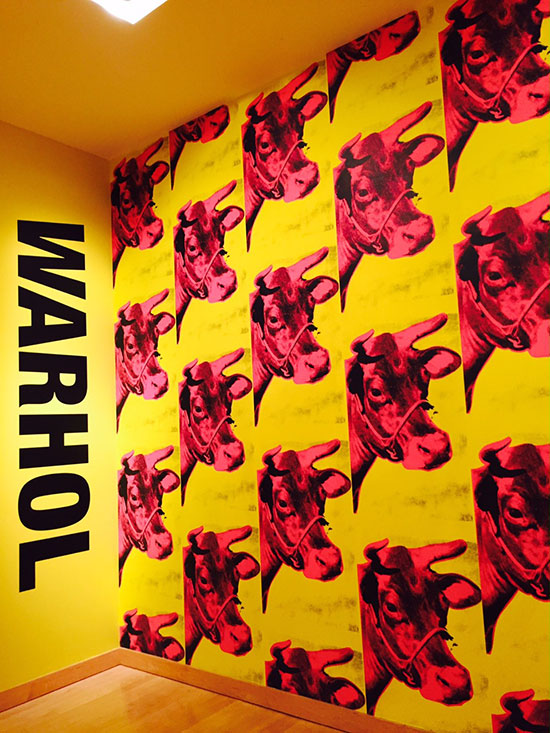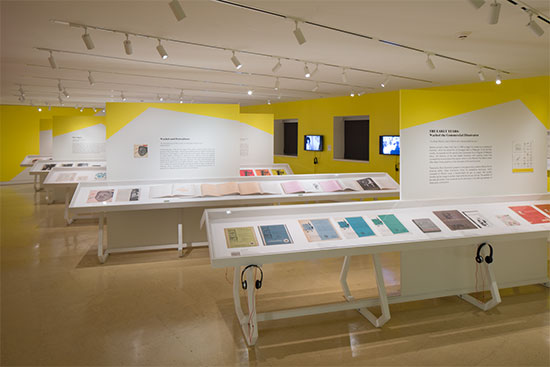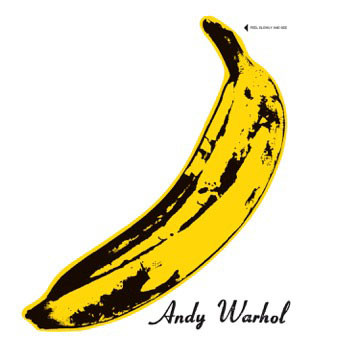In what could easily have been another ho-hum Warhol show of the de rigueur Campbell’s Soup/Mao/Superman/Liz Taylor silkscreens—all of which are included as per the unwritten universal Andy Warhol Curator Contract—the Boca Raton Museum of Art has managed to put together an unexpected setlist of Warhol works in “Warhol on Vinyl: The Record Covers, 1949–1987.”
“Warhol on Vinyl” is one of three legs of “3XWarhol” at the museum, with all three exhibitions on view through May 1, 2016. The other two exhibitions running concurrently are “Warhol Prints from the Collection of Marc Bell” and “Bob Colacello: In and Out with Andy,” featuring Colacello’s candid photos of the ’70s-era Warhol Factory scene.
.

“3XWarhol” at Boca Raton Museum of Art.
.
The “Warhol on Vinyl” exhibition offers an engaging, timely look at variations on more than 50 unique album cover designs the artist created for a diverse array of music. Included in the broad spectrum of genres are albums featuring the music of Tchaikovsky and Gershwin, Count Basie and Artie Shaw, the Rolling Stones and the Velvet Underground. Organized by the Cranbrook Art Museum, the exhibit includes more than 100 album covers, designs, and sound clips, plus a lush coffee table book that provides the backstory for each cover.
.

“Warhol on Vinyl: The Record Covers, 1949–1987" at Boca Raton Museum of Art.
.
The album cover exhibit is in a gallery by itself. Along with the different pieces on view, curators have installed a funky little living room set where visitors can hang out and watch a lost TV show from the 1970s. The show, called “The Wild Record Collection,” features a stuffed polar bear and other stuffed animals dancing to select vinyl 45 rpm singles.
No, really, this is the whole show. This is what public access television was like in the ’70s. And the music, retro even at that time, was popular in the Warhol era, at the beginning of the reign of irony.
The artist’s album covers themselves—lined up in long cases across the room—offer a succinct history of Warhol’s art, starting with neat, sparse pen and ink drawings of jazz figures and classical composers in the ’40s and ’50s and morphing into the more recognizable offbeat “Warhol” style of photo collages and silkscreens in the late ’60s and ’70s. The more avant garde designs culminated in the banana on the cover for the Velvet Underground’s debut album in 1967 and the crotch of a jeans-clad male on the cover of the 1971 “Sticky Fingers” Rolling Stones album. The groundbreaking covers were also very challenging to produce.
.

John Lennon album cover by Andy Warhol.
.

The Velvet Underground & Nico album cover by Andy Warhol.
.
Early copies of the Velvet Underground album invited the owner to "Peel slowly and see." When the skin of the banana (drawn on a sticker) was pulled back, a flesh-colored banana was revealed underneath. A special machine was needed to manufacture these covers, which was one of the reasons for the album's delayed release. But the Stones’ record label, MGM, sprung for the extra costs, speculating that any ties to Warhol would boost sales.
Most reissued vinyl editions of the album don’t feature the peel-back sticker; original copies with the peel-sticker feature are now rare collector's items. Warhol later lamented that he should have charged for royalties on sales as opposed to a flat design fee.
As art, it is great, fruity, Pop fun; as an album cover, it has nothing to do with the band or their music, which makes it even better.
The Rolling Stones cover was even more difficult to produce, as it featured an actual zipper and a second layer of cardboard underneath printed with the image of white underwear. Tinkering had to be done with zipper placement as it was damaging the vinyl record underneath.
The concept was by Warhol, who submitted Polaroids to the designers, but the actual cover photography was by Billy Name and design was by Craig Braun. The mystery model was either Corey Tippin, Jed Johnson, Glen O’Brien or Joe Dallesandro, an endless debate that has long fascinated crotch watchers.
Production challenges aside, the real interest here is in seeing an artist come into his own in a major commercial way, fusing his ideas and skills with both the deep underground scenes and first tier popular rock bands. Warhol had a radical way of making art, truly astonishing ideas about color, and a unique approach to skidding images. He made art more accessible while making it seem easy. He glamorized being gay at a time when homosexuality was still illegal in many parts of the U.S.
He transformed commercial art into high art and high art into mass entertainment. He became a new kind of artist—an icon, an anti-hero, and an obsessive documenter of society. Playing on Warhol’s dictum about everyone “in the future” being world-famous for 15 minutes, New York Magazine art critic Jerry Saltz wrote in a 2012 New York Magazine review of the “Regarding Warhol” exhibition at New York’s Metropolitan Museum: “In the future, every museum will do fifteen Warhol shows.”
As for the art collection selections from Marc Bell, I especially liked the vivid, bright silkscreens with the cowboy and Indian themes—Sitting Bull, Annie Oakley, General Custer, kachina dolls—each rendered with a serious sense of Pop art fun. These prints upend colors and blur edges, making dusty American imagery contemporary and relevant.
What does it mean when images overlap and appear off-register and pile up? Makeup is war paint, faces are green and garish and scribbled upon. Beauty is either tragic or helplessly glam. Pink cows are as important as Jackie O. Hierarchies of representation were breaking down, and the world was slipping in this way, too.
.

"Queen Elizabeth 336" by Andy Warhol.
.
In Warhol, the art world experienced a true revolution, and Warhol was the revolutionary who changed the way the world looked and the way people must now look at the world.
The third leg of the exhibition features candid photos by a fixture of the decadent, glam, disco-and-drugs-driven world of New York in the ’70s, Warhol’s cohort, the writer and one-time Interview magazine editor Bob Colacello.
.

Andy Warhol Backstage with Raquel Welch.
.
Colacello recorded the frenetic pace of the Factory scene, replete with images of Warhol recording that same scene. Augmenting and complementing the Warhol prints and album cover exhibits, this first major museum exhibition of Colacello’s candid photos includes vintage prints and selections from his book, “OUT.”
While the photos are not in and of themselves all that great—hands block faces, stars are chewing mouthfuls of food, or drinking, or bored—“In and Out with Andy” does capture a time and place in a hard- edged, black and white photographic way.
________________________________
BASIC FACTS: “3XWarhol”remains on view through May 1, 2016 at the Boca Raton Museum of Art, 501 Plaza Real, Boca Raton, FL 33432. www.Bocamuseum.org
________________________________
Copyright 2016 Hamptons Art Hub LLC. All rights reserved.
